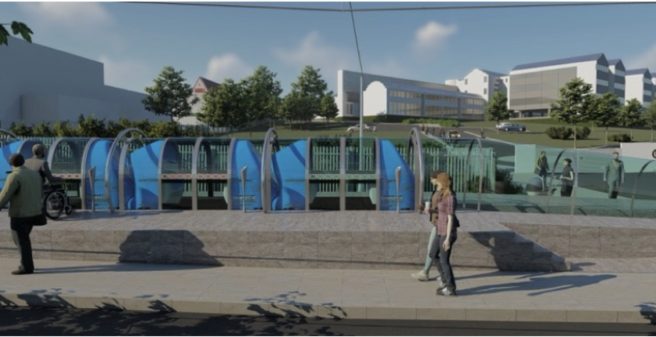
Background
Various unsuccessful attempts have been made in the past to create Personal Rapid Transit (PRT) systems. Such systems rely on small, frequently operating automatic transport units for one or few passengers. With the intention of an attractive and environment-friendly replacement of individual car usage in medium-sized cities between 5000 and 200 000 inhabitants and help converting city centres into pedestrian areas, the idea of creating UrbanLoop as a state-of-the-art PRT was launched in 2017. It relies on powerful information technology in combination with a cost-efficient and user-friendly infrastructure as well as ultra-light smart vehicles. A number of political and scientific entities joined in, either supporting the initiative or participating in project scope definition, idea finding and development of the technology, principles of operation and risk analysis. Those were the French city of Nancy and the “Grand Est” region, four universities of Eastern France with the brain input from more than 100 students and the French “Centre national de la recherche scientifique” (CNRS). System simulations were carried out and early in 2020 a 300 m demonstration loop was opened near Nancy.
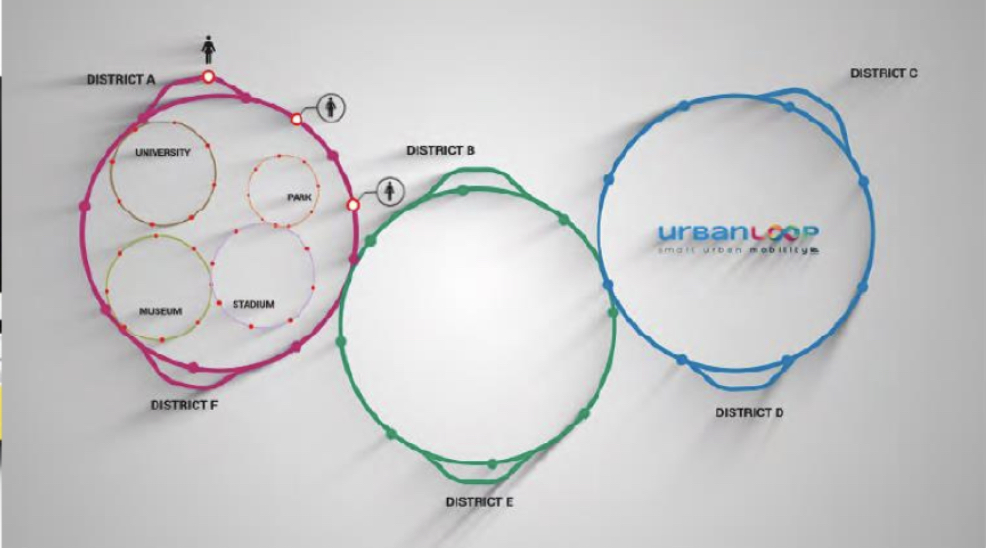
Under the name UrbanLoop SAS, the project has now been established as a start-up company. It plans to open a first passenger-carrying line in Nancy in 2024 and to achieve full certification to launch the concept on international markets in 2026.
The idea
UrbanLoop relies on powerful computation technology to ensure the availability or immediate arrival of a sufficient number of vehicles at stations to satisfy customer demand without waiting time. Passengers order and pay their trip by entering their destination station and type of vehicle on their mobile phone. They will immediately receive a scan code that will give them access to the next available vehicle to bring them directly to their destination without any intermediate stop. In contrast to other public transport networks, UrbanLoop is not organised by lines with vehicles shuttling in both directions but by single-track loops where all vehicles travel in the same direction. Depending on the size of the network, as many loops as necessary are provided and vehicles will select the most efficient path to reach their destination. Passenger alighting and boarding takes place on station sidings while passing vehicles will proceed at full speed.
A video explaining the technology (in French) can be found here:
Operational principles
Based on data obtained from on-board odometrical systems and WiFi communication between the vehicle and the ground, the system is recalculated every 100 ms and mission orders are transmitted to the vehicles and stored thereon. The vehicles therefore select their own path using a mechanical on-board system to actively guide them over the passive turnouts that connect the loops and link the through lines to the station sidings. Stations are sized depending on the anticipated passenger flow, typical lengths are between 3 and 5 vehicles or 10 to 15 m.
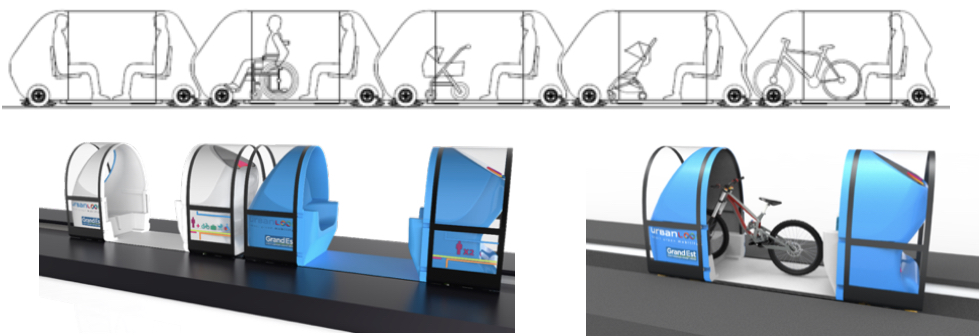
The number of empty waiting vehicles at each station is computed and empty vehicles are sent from stations with overflow to replenish those with a lack of units, so that immediate availability of a vehicle is virtually always ensured. With a maximum system speed of 75 km/h the system will reach a commercial speed from origin to destination of about 60 km/h for the passengers. This is three to five times faster than any other public or private means of urban transport. Furthermore, there are generally no waiting times at the street-level stations. At the same time the lack of breaking and re-acceleration processes during a trip greatly contributes to the unmatched low energy consumption of the system. Fully automatic operation will make the system available 24 hours a day, 7 days a week.
Vehicles are running at 75 km/h line speed with an acceleration of 1.35 m/s2 and a maximum braking deceleration of 2.5 m/s2. They are foreseen to cover about 50 000 km per annum.
The rolling stock
Two types of vehicle are foreseen, the normal type is for one to two seated passengers, the other for a wheelchair, pram or bicycle and a passenger. They are 3.3 m long and 1,02 m wide. Their total hight of 1.64 m with a floor level at 0.39 m results in a comfortable hight of 1.25 m for seated passengers, and standees are not foreseen. Passengers will comfortably walk in and out without bending down. This is possible as there are no left and right doors but the complete middle section of the vehicle will slide open to provide a 1.5 m wide access from both sides without height restriction. Simultaneously opening and closing station doors will be provided. Boarding and alighting will therefore be much more comfortable than in automobiles.
The passenger space is mounted on a steel underframe carried by four rubber-tyred wheels. Thanks to the even running surface on the rails, there is no need for a further level of spring suspension. Four horizontal rolls per pair of wheels on the inner side of the guide rail ensure the track guidance and radial curve steering of the wheels. Outer guiding rolls can be selectively lowered when the vehicle passes through one of the passive turnouts and will guide it to its programmed destination. The underframe furthermore includes current collection shoes, the 3 kW traction and braking motor and transmission that drive the rear pair of wheels, an emergency and parking disk brake, the power electronics as well as the supercapacitors for emergency operation. Acceleration is 1.35 m/s2 and emergency braking deceleration 2.5 m/s2. The total empty mass of an UrbanLoop vehicle is just about 120 kg – roughly 10 % of that of an automobile – thanks to the use of modern lightweight materials and the absence of collision energy absorbing elements and air conditioning equipment. Natural cooling of the infrastructure helped by the vehicle passing ensures that the temperature and air quality within the vehicle will remain at acceptable levels.
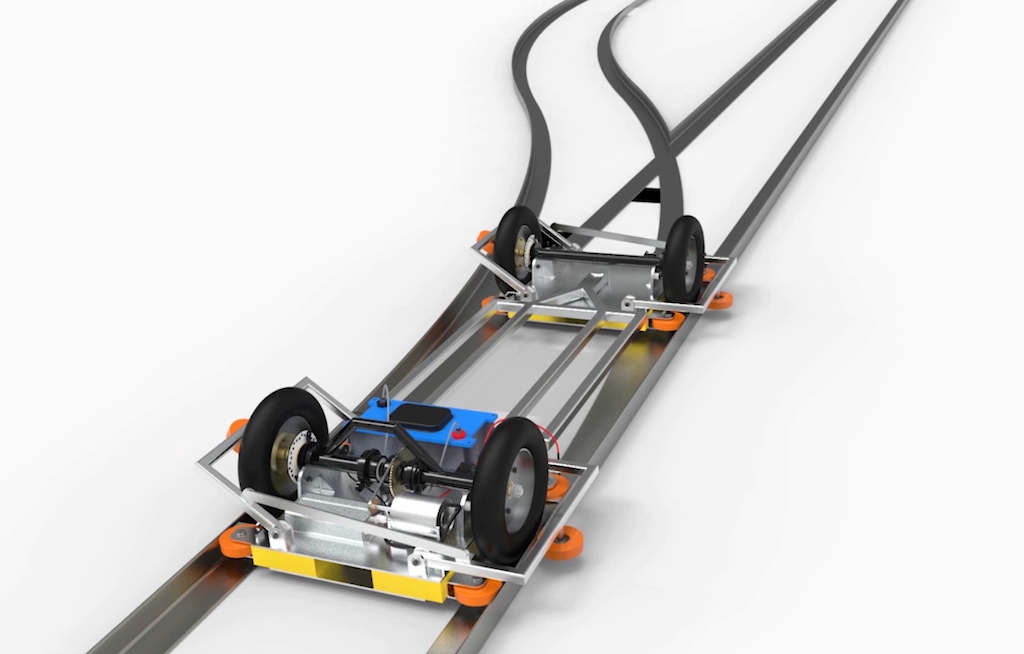
The infrastructure
In order to achieve an easy integration into an urban landscape, UrbanLoop is foreseen to run mostly in 2 m deep tunnel tubes that are laid directly under the road surface while stations are at street level for easy access. With 15 % gradient slopes between tunnels and stations, less than 20 m of line are needed to reach the street level, so that the total required urban space for a station is about 50 m. All stations are offline sidings while the through line for passing vehicles continues underground. The low tunnel height will reduce construction costs and the need for relocation of urban utilities. In pedestrian areas, the upper part of these tunnel tubes is formed by 60 cm wide transparent glass panels that serve at the same time for transparency and daylight. The vehicles tyres run on the horizontal leg of two L-shaped profiles and are guided by the vertical leg. The turnouts have no moving parts, the route selection is achieved by mechanically lowering guiding rollers of the vehicles to the outer sider of the vertical leg of the L-profile. All loops are single-track and unidirectional. They are connected to each other and will form a route network to connect residential areas to working, commercial and entertainment zones. In order to follow inner-city roads, curves as tight as 15 m radius are possible. As a result of the low mass of the vehicles and of the fact that once driving at line speed, the vehicles will not brake and accelerate again, power consumption is very low. Calculations show that about 0.05 kWh per vehicle-km or less than 1 Euro-cent will be needed. For this reason it becomes possible to operate the system with a low-voltage power supply system at 72 V DC through the rails and thus without any danger of electrocution of persons.
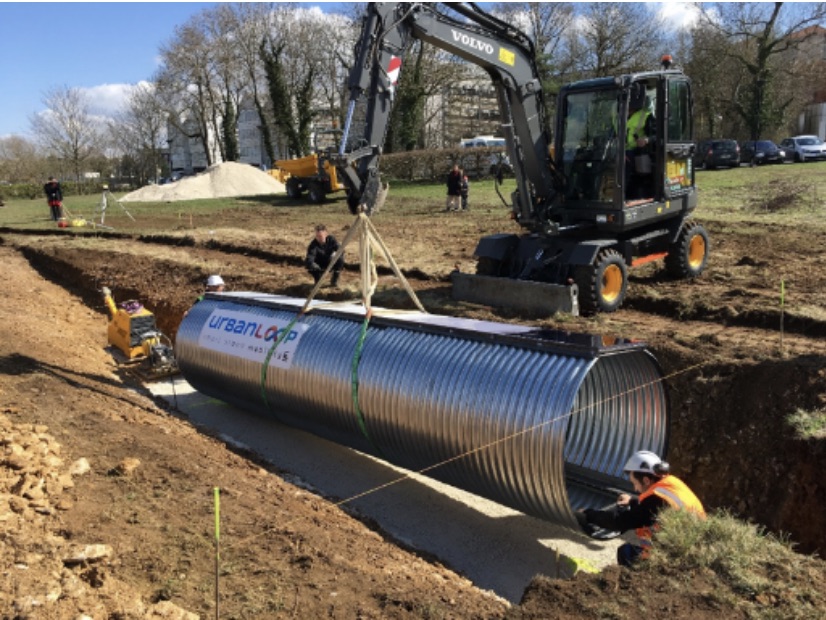
System capacity
Stations are calculated for four vehicle departures per minute at each station, or about 250 passengers per hour. To ensure sufficient safety between running vehicles running on the loops in the theoretical case that a vehicle comes to a sudden standstill, a headway between vehicles of about 8 s between vehicles is foreseen to allow for safe braking. This leads to a theoretical transport capacity of about 500 passengers per hour. This number has to be reduced by taking into account about 40 % of empty vehicles that circulate on short distances to be removed from stations with a vehicle overflow and to replenish other stations. The total transport capacity of a system depends on the number and arrangement of loops to match the specific conditions of a city. Studies are underway to increase the system capacity by a virtual coupling of vehicles so that they can operate like trains on shared parts of their route.
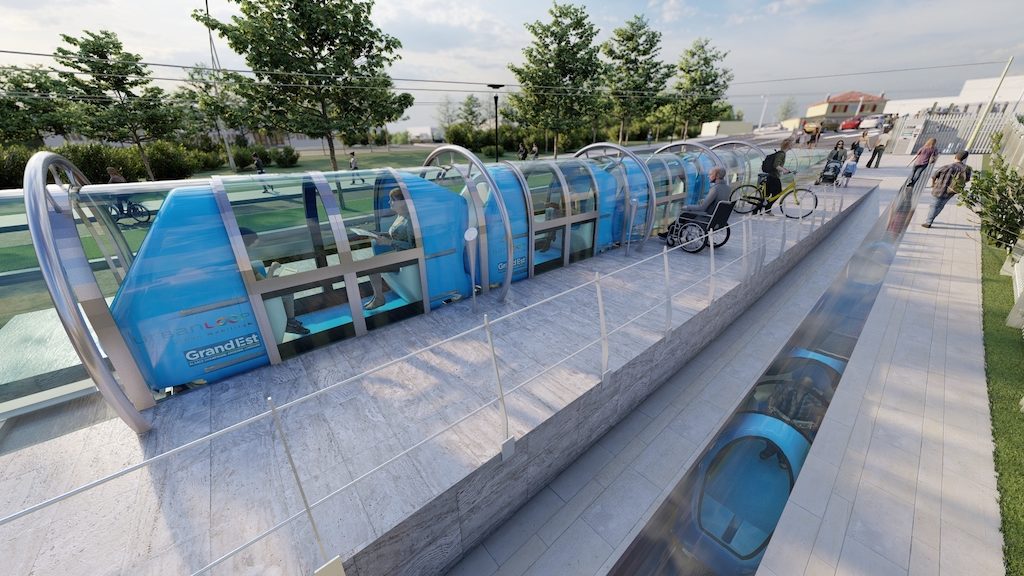
Safety and security
The evolution of the system has been continuously monitored by STRMTG, the French safety certification body for guided urban transport systems and to-date favourable statements have been emitted. Some issues are highlighted here. A fully automated system must have provisions against intruders; this is guaranteed thanks to the fully enclosed system that can only be entered through station and vehicle doors. Should there be a software failure, each vehicle would complete its recorded mission; in case of a power supply failure, a small supercapacitor energy storage on each vehicle will allow to continue for about 100 m to reach the nearest station. Should vehicles be blocked between stations, they may open the vehicle doors. A 75 cm wide escape way is provided and passengers can also be evacuated through the glass panels over the tunnel that may be easily removed from the interior.
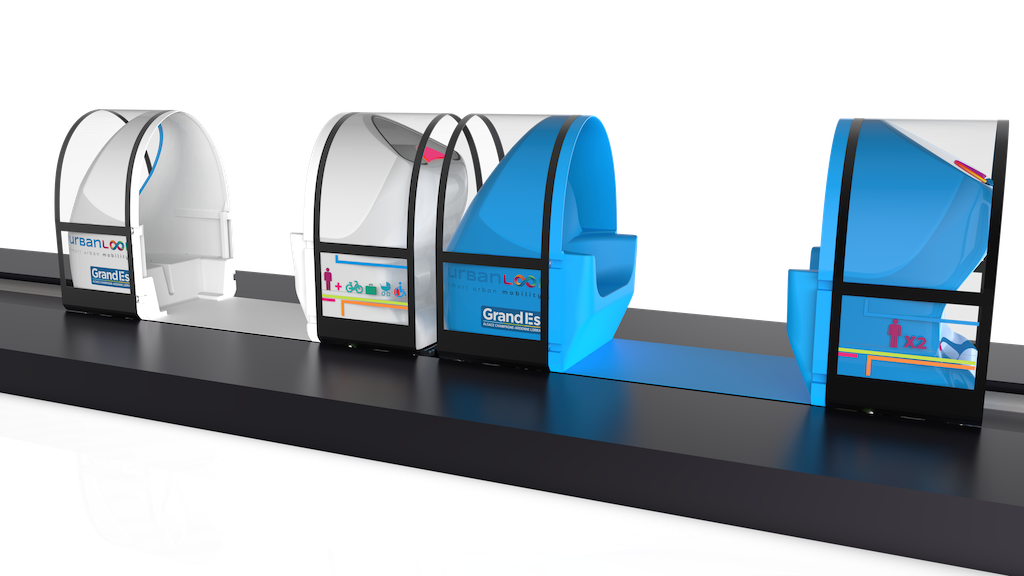
Project status
Starting in 2017 as a University project in the French Grand Est region, and with the brain input of almost 200 students, the transport system scope and its main requirements were defined. The basic concepts and a system simulation software were developed. A 1/10 scale demonstrator to verify the routing performance was built in 2018 and in 2019 a rudimentary full-scale 300 m demonstrator loop was taken into service and tested. In the same year, the UrbanLoop SAS start-up company was constituted and patents were deposited. A market analysis was made and 37 cities in the Grand Est region were identified as potentially suitable for the system. In 2021 the construction of a full-scale prototype system with two 3.5 km loops, 4 stations, 3 vehicles and a depot are under construction near Nancy. It will serve for system certification. For 2024 the construction of a first passenger carrying loop for final certification and as a showcase is planned.
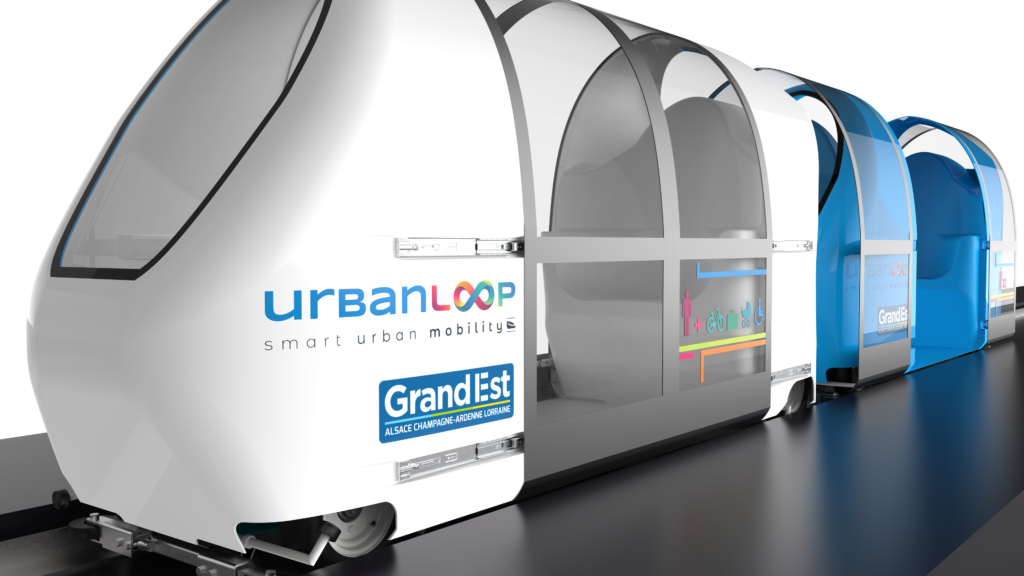
Author’s comments
At first sight the idea is inspiring, and its definition and engineering has taken into account all important factors. Nevertheless, there are some more ideas about it and some questions remain, mainly regarding transport capacity and accessibility.
A big chance for UrbanLoop would be its expansion to freight delivery in order to ban trucks from city centres. Such a philosophy, under the name of Elcidis, has first been introduced in the French city of La Rochelle in 2001 but also operates in Rotterdam, Stockholm, Erlangen, Milan and Stavanger. It uses driven electric delivery vans. UrbanLoop could take up this idea and deliver goods and remove waste between a logistics hub and shopping centres and other areas during off-peak hours. Automated logistics vehicles and freight terminals would have to be developed or adapted from existing solutions in the logistics sector.
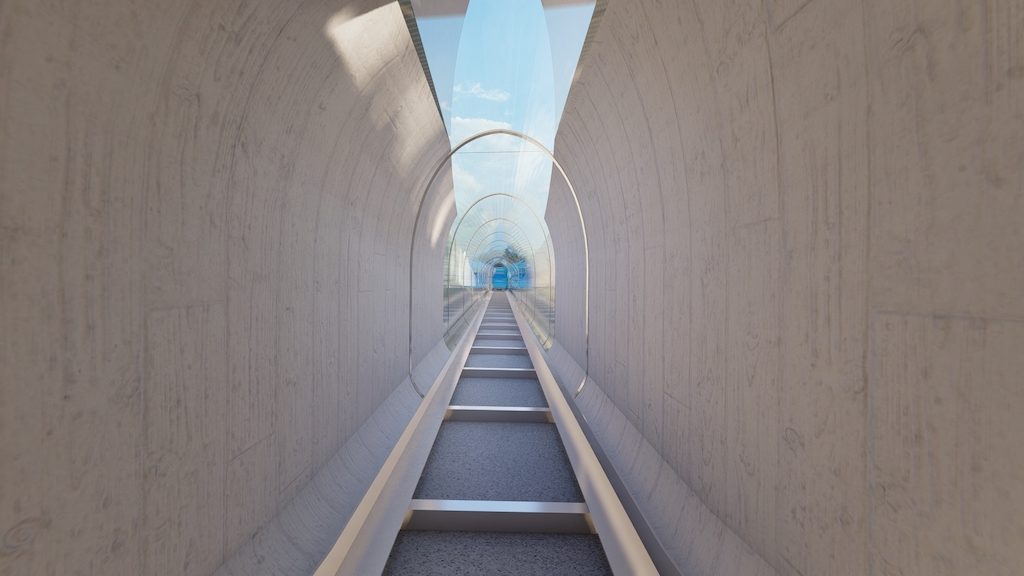
The system is highly automated and does not take into account the roughly 10 % of the population who do not have a bank account nor a mobile phone or who are not able to handle it. And it is exactly these persons who are not likely to be able to drive a car either.
As stated by the promotors, the system is intended for smaller cities; the author nevertheless questions if its maximum capacity can reach the necessary levels of a city with 200 000 inhabitants where during peak hours dozens or even hundreds of passengers get to the stations every minute, in performant tram or bus systems and where trunk line capacities are in the range of several thousand per hour and per direction. One might think of reducing the speed on the denser parts of the loops to reduce headways proportionally, so as to achieve something like 1s headways at 10-15 km/h and increase the capacity to 3000 passengers approximately. But then, station capacity must be increased manyfold as well; this might be done by increasing the station length to receive more vehicles, by doubling lines or station tracks and by reducing the distances between stations. But too long and too many stations in much frequented pedestrian areas is not attractive, so that some stations might still stay underground but may also be integrated into department stores or office buildings. It might also be possible to have loops partially running in parallel and to have an increased number of loops in the denser areas of a city.
12.02.2021

Good idea but pods have been carrying passengers at Heathrow Airport, London since 2010, yet I haven’t seen a lot of pod lines being introduced.
I know the city of Nancy well , and I have read a lot of papers about this project. If this project is to train students about complicated technical problems, OK it costs money for the taxpayers inhabitants but it will have positive effects on the knowledge of the students. If this project is to solve transportation problems, the first step would have been to learn about urban public transport. When you read the texts and see the videos, there are a lot of questions about security, acceptability, efficiency, costs and so on, and there are neither questions nor anwers in the Urbanloop papers. In Nancy in the seventies, the TRP TTI Otis project; I remember a young engineer friend of mine , who new nothing about public transport but with the task to implement this project. First failure. Later, the Bombardier TVR Tram on tyres ; it works but with very high costs and low efficiency ; second failure. So, as we say in France “never two without three”, we know now the third failure in Nancy, Urbanloop. For Nancy, people (journalits, elected) dream and don’t want to study an efficiency solution, which is the trolleybus IMC (see http://www.unispournancy.fr/transports.php). For one succeded futuristic public transport project (Automated metro VAL), how many projects died because of a bad analysis of the problem with a lot of money spent for nothing? pdebano@laposte.net
Being the author of the article, I have to say that contrary to other ideas this project has been thoroughly studied and is very promising, I had long discussions with its promoters, and it is not just hot air. The main environmental advantage is its very low energy consumption. Please note that of course, safety (not security, that is an other issue) is monitored by the French urban transport safety authority STRMTG. Please read also my part on system capacity and my “author’s commments”, so you will see it has a targeted transport volume and is intended for rather small citeis, and some questions still remain, so let’s wait for the next stage of development and its outcome. My main question meanwhile is the accessibility for the about 15 % of people who cannot or do not use mobile phones or any other electronic device, how will they be able to use such a system (and it could well be that those are also the ones who can not drive a car or own one)?
Interesting concept. Kudos on building a prototype. Reducing the weight of the vehicles and electrical supply through the rails (so minimal energy storage weight) is a good idea.
The tunnels and surface level stations will minimise visual pollution and provide convenience to passengers.
However:
Maybe they have this figured. I look forward to what they achieve.
Hello Tim, many thanks for these comments that are well thought of. The project has gone forward, I have recently seen the demonstration line, and some issues have been improved. It nevertheless will need more development work and your comments might interest the UrbanLoop peaple, so I take the liberty to forward them. I will soon publish an update in UTM.